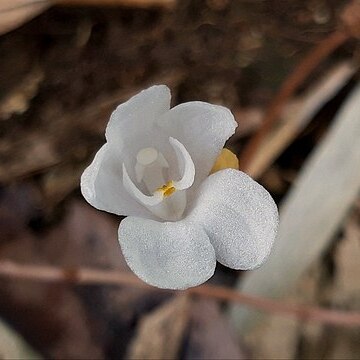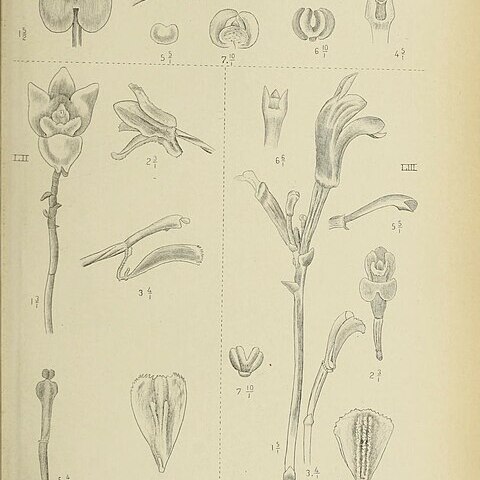Plants 6-25 cm tall. Rhizome pale brown, fusiform or moniliform, 8-25 × 5-8 mm; roots few to many, wiry, often with small globose thickenings. Stem 5-20 cm, with 3-5 scalelike sheaths, pale brown to reddish brown. Rachis 0.4-3 cm, elongating in fruit, laxly to subdensely 4-20-flowered; floral bracts ovate, ca. 2 mm, apex acute. Flowers opening in succession, white, campanulate; pedicel and ovary erect, brown, 0.7-1.2 cm; pedicel extending to 15 cm in fruit. Dorsal sepal and petals 4-7 mm, usually united for more than 1/2 of their length, free portion ovate-triangular, shallowly 3-lobed, each lobe ovate-deltoid and with an obtuse apex; lateral sepals 3-4.5 mm, connate with each other for up to 1/2 of their length, and with petals for 1/3 of their length, free portion 2-lobed, each lobe ovate and with an obtuse apex, reflexed; lip broadly obovate, 4.5-5 × 6-7 mm, erose-crenate, lateral margins erect or incurved, apex subtruncate; disk with a dense row of warty papillae along midvein. Column slightly curved, clavate, ca. 4 mm, apex dilated and with 2 oblong wings; column foot slightly curved, 2-3 mm; anther orbicular. Capsule cylindric-fusiform, 2-2.8 cm. Fl. and fr. Apr-May.
More
Flower stem 60–120 mm long, whitish, yellowish or pinkish, fleshy, brittle, 5–15-flowered. Flowers semi-erect, 6–8 × 8–10 mm, crystalline white, (sometimes with brown markings), opening singly in succession up raceme. Sepals and petals fused into floral tube for about half their length. Labellum broadly wedge-shaped, 6–7 × 9–10 mm; margins incurved and hugging column; apex often notched or lobed. Calli cream to yellow, arranged centrally in 2 or 3 irregular rows. Capsules erect, pinkish brown, on elongated pedicels 30–40 cm long.
A localised and unusual species that grows in a range of situations including springs and seepage areas in grassy forest, riparian forest, monsoon forest, and rainforest in wet, black, peaty soil; also in grassy or sedgy swamps where it grows in open areas between tussocks, or even inside the tussock itself; also among litter in bamboo groves in grey clay loam. Sites where it grows are usually wet and can be subject to short periods of inundation.


